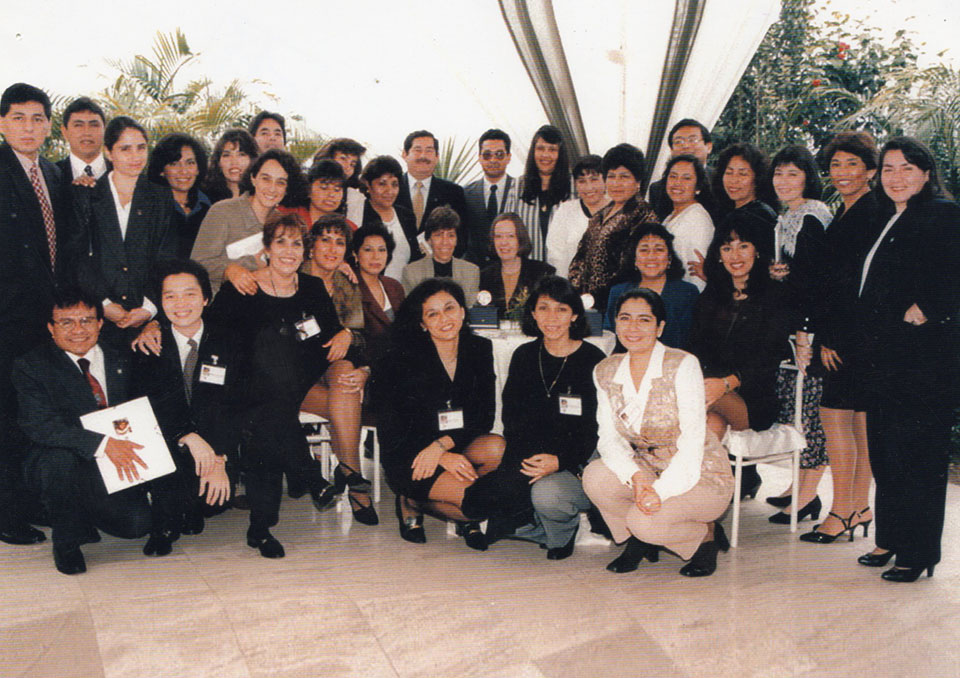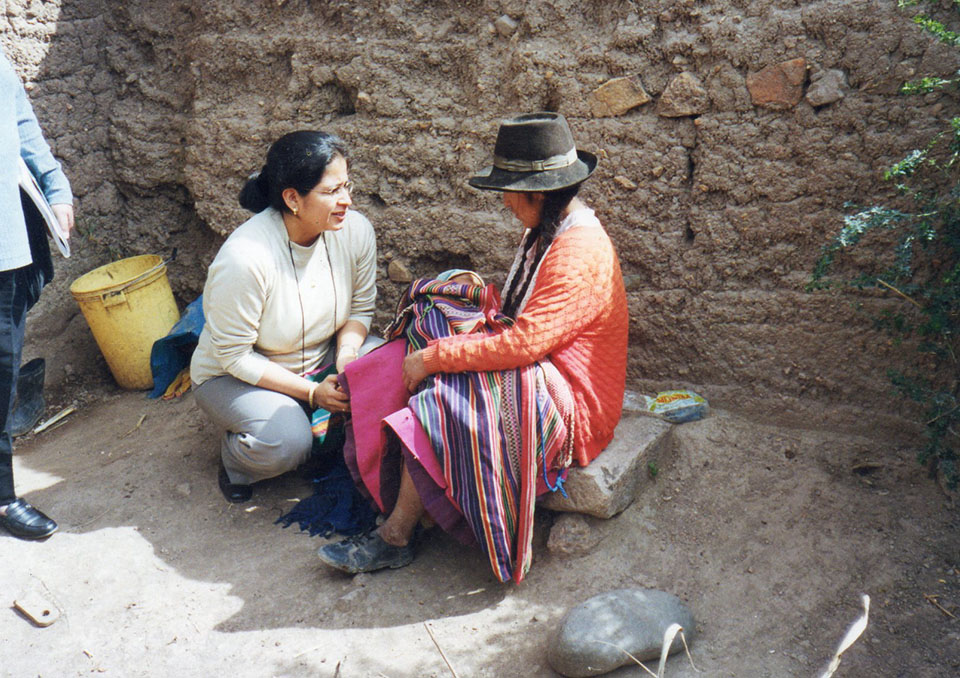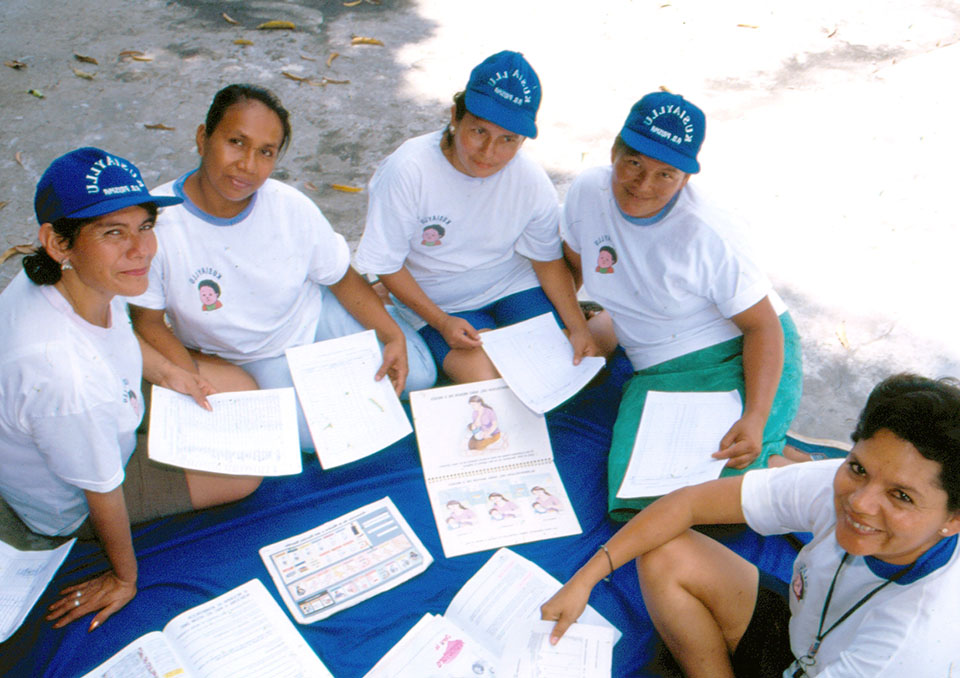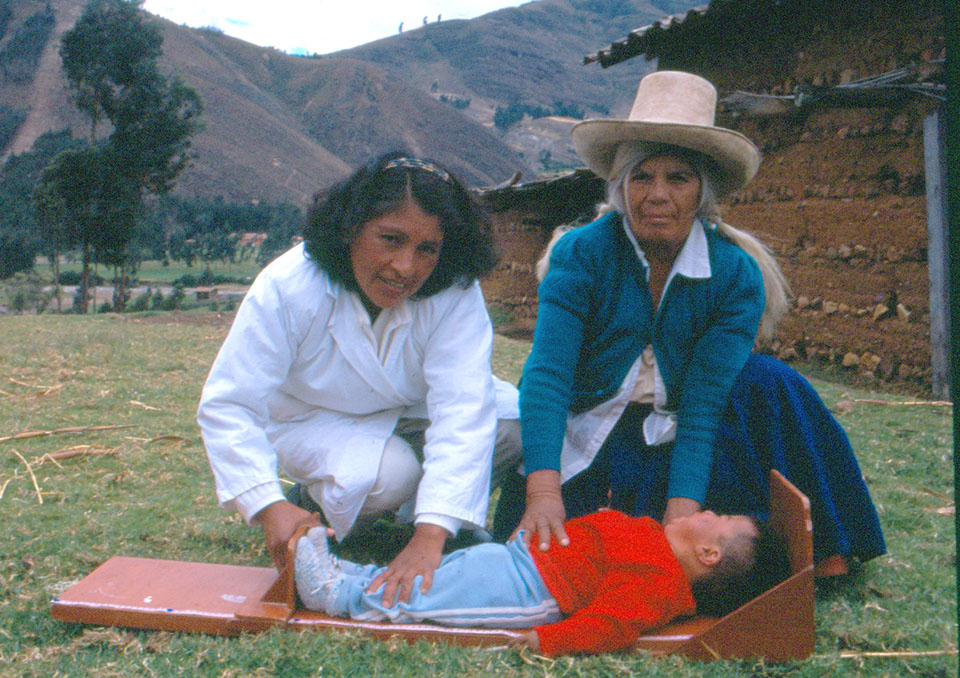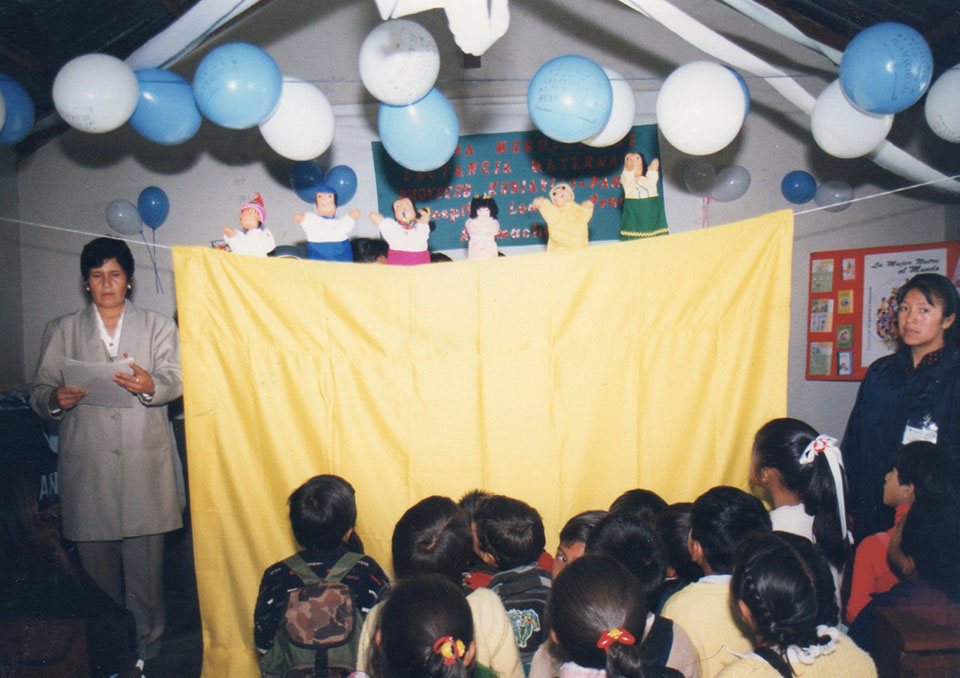PRISMA was founded in Lima on April 23rd, 1986, based on the initiative of a multidisciplinary human group concerned by chronic childhood malnutrition and the risk factors associated with it.
Pampas de San Juan of Miraflores was the scene for the first experiences of this group of young professionals. The human settlement located in the Southern Cone of Lima was part of the third major urban expansion of the capital, characterized by invasions of poor migrants and a lack of basic services, among other things.
In Pampas de San Juan de Miraflores, Prisma implemented the Risk Project (“Proyecto Riesgo”), a longitudinal study carried out over a period of 10 years (from 1986 to 1996) and financed by the the United States Agency for International Development – USAID. This study showed that it was possible to predict the timing and determinants associated with chronic malnutrition and infant mortality in the community.
The knowledge gained became the basis of the institutional initiative model for health protection and the nutritional status of children under 3 years of age.
CHILDREN
One of the first activities carried out by Prisma was the issue of the magazine “Niños” (“Children”), a publication freely distributed that allowed the institution to be positioned as a reference in matters of child health and nutrition.
Eleven issues were developed, each one related to a child survival topic.
It was distributed by the pharmaceutical company representatives of Ciba-Geigy and the PANFAR team, to health providers that worked in inland health centers.
Several years later, all the issues were updated and published in a compendium (1988 to 1990). To this day, there are people who ask us about “Niños” magazine or who have cited it as a bibliographical source in research work.
This experience was very novel for this time, since malnourished children were rehabilitated only at specialized centers. Focusing and intervening in the home with clear criteria made the difference.
This model that promotes quality and coverage of health services, healthy practices at the household level and the improved management of social programs with nutritional goals, has been shared with many organizations, including the official public sector.
This first enriching experience motivated Prisma to successfully participate in the competition to implement at the national level, in agreement with the Ministry of Health and with financing from USAID, the PANFAR (Programa de Alimentación y Nutrición a Familias de Alto Riesgo – Food and Nutrition Program for High-Risk Families) program, in which Prisma assumed responsibility for food logistics, field supervision of program activities and the training of implementation personnel on issues related to the program. PANFAR lasted 10 years, after which the work done transferred to the Ministry of Health, where it continued until 2002, when the Peruvian government decided to centralize all social programs through MIMDES.
During PANFAR’s 10 years, the global context changed rapidly, dizzying advances in technology allowed for more accurate focusing on areas of greatest vulnerability and making immediate decisions based on reliable data input by leaders of the IT modules Prisma implemented, in a first phase, in the then Departmental Health Units and later, in the Territorial Health Units.
The field experience gained led to the initiation of a new strategy aimed at malnourished children less than three years old, with trained Health Promoters engaging in house-to-house nutritional monitoring; this program was called KUSIAYLLU. In turn, PANFAR became the integrated program of the Ministry of Health, because it included prevention and rehabilitation measures for all members of beneficiary families. Both programs became part of Prisma’s Health and Nutrition Directorate.
Processed by the then Research Directorate, the data obtained throughout those years was valuable information that generated knowledge applicable in other areas of the country, which was later reflected in widespread scientific texts. The quality of the professionals and the experience gained in this direction made it possible to work on a group of projects financed by foreign universities could work, which, to this day, continue to send volunteer interns or prefer PRISMA as a headquarters to undertake studies, particularly in medical epidemiology.
A year later, the reproductive health initiative was introduced as part of the organization. Initially with the sponsorship of USAID, the technical management abilities of five national, private institutions were strengthened. Subsequently, projects with diverse objectives were carried out, covering self-awareness, capacity-building for health personnel and promoters, access to user information and contraceptive logistics, which resulted in Prisma were responsible for the logistics of contraception both in the private and public sectors, at the national level.
Rapid changes in the world context, influenced by globalization, promoted the reassessment of governmental strategies, which were affected by the immediacy of communications, economic behavior, markets, money, and wars. Nevertheless, for the majority of people, the meaning of life continued as it had before, that is to say, the local reality. This need to bring people closer to this global world motivated the institutional decision to incorporate technical assistance, training and capacity-building, as well as to promote the link between people and institutions in all its projects. We believe it was the best way to avoid the view that globalization is a threat, and instead is a valuable new opportunity.
CEAT
Many of the microcredit and CEAT activities demonstrated the difficulties of farmers in the production, financing and market search for their products.
In response to this need, PROFAR: the Productive Chains Financing Program with Risk Management, financed by AECID in collaboration with Properú, was developed much later, with the aim to reduce the high vulnerability of the rural agricultural producers.
The versatility, adaptability to change and abilities of the Prisma team undoubtedly supported the reorientation of institutional policies. The data obtained from the longitudinal monitoring of Pampas de San Juan de Miraflores showed the need to improve people’s abilities in order to take advantage of the opportunities to have better income through stable employment and access to credit, activities that needed to be sustainable.
Then come Social Development projects, later those of Sustainable Development and Alternative Development thus creating the Social Development Board. Based on knowledge about the target population and the development of participatory diagnoses to identify perceived needs, intervention models were being formulated to solve the problems that prevented from having a fulfilling life. It was always kept in mind that development projects take a longer time to mature, generate trust and achieve the involvement that is required in the target population.
The Board of Social Development and Training was in charge of designing the PASA and CEAT projects. The Food Security Support Program (PASA) was the origin of the current Microfinancing Division and was originally aimed at graduates of the health and nutrition programs in six parts of the country. Prisma knew the population and it recognized the institution for the transparency of its actions in previous projects.
The experience evolved allowing growth under the method of community banks and solidarity groups, and subsequently, with individual loans. Microfinance Prisma operated in 12 regions in the country and had more than 30 strategic partners, both national and international. Its customer base was located in rural areas (43%) and urban slums (57%), serving male and female microentrepreneurs in the commercial, agricultural, services and production sectors. 58% of the total clients were women and in the community banks, this percentage reached 74%.
The CEAT Project was born with the aim of contributing and improving income in the rural population, centered around the improvement of production in quality and quantity and in the generation of alternative commercialization channels for greater productivity via the establishment of Collection Points and Transformation Centers, hence the name CEAT (the acronym for this initiative in Spanish). These centers, which in the case of the Cajamarca region involved the construction of a plant and in the case of Junín and Cusco consisted of the development of alliances with existing plants, had to produce fortified and pre-cooked food for children’s diets from six months of age; this gave rise to PANFARCITO.
The promotion of Comprehensive Adult Health was also a concern for the Prisma team and in this field, the projects basically focused on the prevention of HIV/AIDS and on research into diverse related issues.
ENVIRONMENTAL MANAGEMENT
From 2001, Prisma implemented a new initiative known as RETAMA (Suitable Technological Resources for the Environment) focused on the issue of Environmental Management, starting with the first urban solid waste management project with the Provincial Municipality of Cuzco, financed by USAID and the Fund of the Americas.
To date, the RETAMA center continues to function in the SELIP (Public Cleaning Service) – Cuzco and in the Rayallacta community for the management of inorganic and organic wastes, respectively.
In 1994 the Ethics Committee was formed, initially aimed at reviewing the institution’s epidemiological studies, later extending its scope to offer services to the scientific community for the clinical trials reviews, ensuring the rights, well-being, and safety of the participant human beings in research work. Prisma’s Ethics Committee is registered in the National Institute of Health and is one of the most recognized in the country.
In 1996 the warehouses of Agustino and Trujillo were constructed for logistical management of donated food, at first, and later, of contraception. This work was complemented and strengthened in 1998 through PALA –Support for Contraceptives Logistics Program- developed with the Ministry of Health– MINSA and NGOs dedicated to family planning.
Based on the Strategic Plan undertaken in 1999, the institutional opening for the diversification of funding sources was initiated. In parallel, work continued with the financial support of The United States Agency for International Development –USAID. Thus, in 2000, PRODECCE, a Community Development Program in Economic Corridors, was designed and implemented, aimed at integrating three components: social capital, economic productivity and market access. With this project, eight corridors of Peru were intervened into.
USAID was Prisma’s main financier until the middle of the first decade of 2000, working mainly under the DAP (Development Activities Program / Programas de Desarrollo) scheme, which allowed the parallel financing of complementary food security projects until 2001.
Between 2002 and 2006/07 Crecer Sano and ALIANSA were implemented, projects on child health and nutrition, SAP or commercial Agricultural Services for agricultural production and commercialization, and Microfinancing, with the resources of PL 480- Title II, which allowed work in 17 regions in the country.
Crecer Sano was geared towards direct work with families to improve childcare practices and ALIANSA became the basis for the initiative to strengthen local governments, which not only considered health problems with the health sector and mothers, but also initiated the involvement of stakeholders with the decision-making capacity over the investment of public resources.
The SAP- Agri-Business Services incorporated the market-demand approach, seeking to generate incomes so that the population could finally improve its quality of life. The initiative included three components: promotion and strengthening of the organization, production improvement and technical assistance to access the market.
The work experience in nutritional program management with local and regional governments enabled, from 2006, the beginning of implementation projects to strengthen local and regional governments. Since then, a new Prisma initiative, Institutional Strengthening, was formally created.
Parallel to the Ministry of Health changes from vertical programs to the comprehensive care model, the Logistics Area continued to assist with the Medication System Support Project –SISMED from MINSA, first designing and validating the model and later implementing it in six regions in the country. Since 2007, in partnership with John Snow International (JSI), the area team has been dedicated to capacity-building in medication management not only in Peru, but also in the entire Latin American region.
At the end of 2006 the health project was completed and in 2007 so was the production project, closing the PL 480 Program in Peru. From then on, the diversification of funding sources at Prisma and the consolidation of initiatives have gained momentum.
ALTERNATIVE DEVELOPMENT
The health component in the coca valleys has worked since 1996, and in the production, since 1998. It is with this experience that the S@mconet developed as a form of bringing pricing information to the producers.
As of 2004, in partnership with Pathfinder, the Prisma team designs the template for “Healthy Communities and Municipalities in Alternative Development areas”, through which community empowerment is achieved for the design and construction of its own development.
Hand-washing Initiative
In response to a World Bank initiative that coincided with the Prisma team’s need to better understand how to fine-tune educational activities for behavioral changes, a diagnostic study of handwashing behavior with soap was carried out in 2003.
The results of this study have been important in improving the impact of our educational initiatives. These results were validated with the implementation of the pilot project of the Handwashing initiative, financed by the Japan Social Development Fund, through the World Bank.
The second phase of the Handwashing initiative in schools and communities was implemented in 10 departments in the north and center of the country.
The Human Development and Economic Development direcciones worked jointly on the communication, training, and logistics components of the “Malaria Control in the Border Areas of the Andes Region: A Community Approach” (PAMAFRO) project, financed by the Global Fund through the Andean Health Organization (ORAS-CONHU). In addition, the social initiative for patients with multi-drug-resistant tuberculosis-TB-MDR started through Objective 4 “Strengthening Support and Social Rehabilitation of those Affected by Tuberculosis” of the 5th Global Fund Round, administered by CARE. Further, work was done on the issue of neonatal health (Healthy babies).
As of 2008, continuous work started with several private companies through corporate social responsibility projects (Hunt Oil, Pluspetrol, Fundación Inca Kola, Conoco Phillips, Textil del valle, Cerro Verde, Consorcio Minero Horizonte, Kraft Foods, Cía. Minera Barbastro y Sillustani, MINSUR, among others.). The PL 480 work experience was standardized in water and sanitation infrastructure, work with native communities was resumed and small education pilots were developed.
At the end of 2008, the Governance and Transparency Project was launched, with funding from the UK Department for International Development (DFID), which allowed it to resume its institutional presence in 14 regions of the country for 5 years.
In 2009, Prisma plans its new institutional vision for the next five years, taking on new challenges of institutional strengthening and internationalization.
The beginning of this path marks the selection of Prisma as a regional institution of training and technical assistance in matters of public health logistics for Latin America by the Regional Initiative of Institutional Development (RIDI), backed by USAID’s Project DELIVER in 2012.


